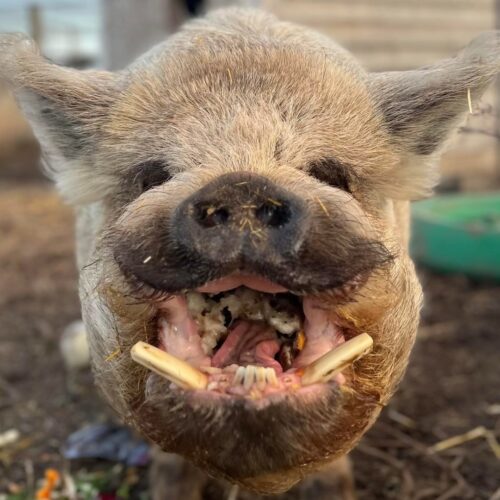
Federal Report Recommends Breaching Lower Snake River Dams To Restore Salmon
Listen
Runtime (1:46)
Read
To recover healthy salmon populations, one or more of the Snake River dams must be breached, in addition to other actions, according to a new draft report released Tuesday, July 12 by federal officials.
The National Oceanic and Atmospheric Administration, which manages threatened and endangered salmon and steelhead, prepared the draft report, with input from the U.S. Fish and Wildlife Service, the Nez Perce Tribe, and the State of Oregon, which have been involved in ongoing litigation about the federal plan to operate the Columbia River hydropower system.
“Salmon recovery depends on large-scale actions,” according to the NOAA report. “Inaction will result in the catastrophic loss of the majority of Columbia River basin salmon and steelhead stocks.”
The NOAA report shows what it will take to restore salmon to healthy and harvestable numbers, said Brenda Mallory, chairperson of the White House Council on Environmental Quality.
“Business as usual will not restore the health and abundance of Pacific Northwest salmon. We need a durable, inclusive, and regionally-crafted long-term strategy for the management of the Columbia River Basin,” Mallory said.
In another report also released July 12, federal officials from the Bonneville Power Administration commissioned an independent analysis by the consulting firm E3 that looked at ways to offset any electricity generation from the four dams on the Lower Snake River.
The E3 report found it’s possible to replace electricity generation as emerging technologies, such as small modular nuclear reactors and floating offshore wind turbines, become more commercially available.
Replacing the electricity generation from the Snake River dams could cost $11.2 billion to $19.6 billion, which is similar to costs outlined in previous studies. At the high end, which officials deemed unrealistic, that cost could reach $77 billion, according to the report.
For ratepayers, replacing the dams could mean $100 to $230 per year more in electricity costs in 2045, around an 8% to 18% increase in bills.
“As the region continues to embrace the health and cost-savings of a decarbonized power sector and to further enhance its supply of clean energy, the E3 study can help inform long-term planning decisions, including to limit the impact to ratepayers,” said Kathleen Hogan, U.S. Department of Energy Principal Deputy Under Secretary for Infrastructure.
The Biden administration did not endorse the actions outlined in either report. However, federal officials said the administration is considering the information in these reports as it assesses long-term plans for the Columbia River Basin, a first for recent administrations.
Many groups that would like to see the dams removed said momentum appears closer to dam removal than it has over the last few decades.
For example, Washington Gov. Jay Inslee and U.S. Sen. Patty Murray, both Democrats, are expected to release recommendations this month on what they think should happen with the dams. According to a separate draft report issued in June that will guide Murray and Inslee’s recommendations, breaching the dams would be the best way to remove Snake River salmon runs from the Endangered Species List and would best maintain treaty and trust obligations with tribes.
Earlier, U.S. Rep. Mike Simpson, R-Idaho, outlined ideas to remove the four dams in a $33.5 billion proposal that would have replaced the additional services the dams provide, including irrigation for agriculture, transportation, and carbon-free energy.
Removing the dams would take an act of Congress, according to federal officials.
U.S. Rep. Dan Newhouse, R-Wash., has long advocated keeping the dams in place, most recently leading members of the Congressional Western Caucus on a tour of Ice Harbor Dam near the Tri-Cities. Newhouse represents an area that includes some of the Snake River dams.
Newhouse released a joint statement with fellow Reps. Cathy McMorris Rodgers, R-Wash.; Jaime Herrera Beutler, R-Wash.; Cliff Bentz, R-Ore.; Russ Fulcher, R-Idaho; and Matt Rosendale, R-Mont.
The statement sharply criticized the NOAA and E3 reports, noting the federal agency cherry-picked talking points that would lead to dam breaching, which the representatives wrote would negatively impact people in the Northwest.
“The Biden administration is talking a big game on carbon goals while simultaneously engaging in actions to undermine valuable clean, affordable and renewable power resources on the Columbia River System, thus compromising energy stability across the region,” according to the joint statement.
The first NOAA report prioritized the recovery of each salmon stock listed under the Endangered Species Act, with the Snake River spring/summer chinook and steelhead at the top of the list. In addition, the report examined the outlook for each of the 16 stocks that historically spawned above Bonneville Dam, calling the short-term outlook for interior Columbia Basin stocks grim.
Of the 16 historical salmon stocks in the Columbia Basin, four are extinct; seven are included in the Endangered Species List; and one of the listed stocks is reliant on hatchery programs. One stock fares better, approaching historical numbers.
However, according to the NOAA report, longer-term outlooks provide a brighter spot because of increasingly effective stream and estuary rehabilitation programs, large-scale habitat improvement projects, and hatchery and reintroduction efforts.
“All optimism about future stock status must be tempered by the continued pressure from a changing climate and the ever-expanding human footprint,” according to the NOAA report.
As climate change worsens, threatened and endangered salmon will face more risks, according to the report, which means opportunities to rebuild imperiled stocks will continue to diminish.
Climate change will continue to increase droughts, wildfires, and vary river flows in the Northwest, according to the report. In addition, climate change will be less manageable in ocean conditions and marine environments, where salmon spend a majority of their lifetimes.
“The increasing role of deteriorating ocean or freshwater conditions from climate change on the health of the salmon and steelhead stocks does not diminish the importance or necessity of taking meaningful actions in areas society has direct influence over,” according to the NOAA report.
In that light, management actions should prioritize increasing salmon resiliency and adaptation to climate change, according to the NOAA report.
To do that, society has direct influences over restoring properly functioning tributary habitats, which can help salmon as snowpack diminishes, and improving migration areas human influences degraded, according to the NOAA report.
“We are at a crucial moment for salmon and steelhead in the Columbia River Basin when we’re seeing the impacts of climate change on top of other stressors,” said Janet Coit, assistant administrator for NOAA Fisheries.
While no single action will act as a silver bullet, a diverse combination of management actions could help improve salmon and steelhead survival to reach “healthy and harvestable stocks” in the face of climate change, according to the NOAA report.
The report also looked at mid-range goals of fish abundance set by the Columbia Regional Partnership, which decided that salmon populations in the Columbia River Basin needed to be higher than the threshold for Endangered Species Act recovery goals. Instead, the task force recommended fish stocks reach what it called healthy and harvestable numbers.
To achieve that goal, according to the NOAA report, managers will need to take several actions, including removing one or more of the four Snake River dams, reducing the number of predators, restoring and protecting tributary and estuary habitats, adding fish passage above Chief Joseph and Grand Coulee dams, and reforming hatchey and harvest practices.
“These actions are needed to provide the highest likelihood of reversing near-term generational declines and toward rebuilding healthy and harvestable runs in the face of climate change,” according to the report.
In addition, these actions, which the NOAA report noted science supports, should be implemented as soon as possible.
Trout Unlimited, which has argued to remove the dams, said removing the dams could be transformative for fish, and possibly help salmon even faster than the report indicated. That’s because breaching the Snake River dams will help salmon and steelhead reach hundreds of miles of rivers and streams more quickly, said Rob Masonis, vice president for Western Conservation at Trout Unlimited.
“This is the golden key that will unlock the benefits of other salmon recovery investments,” Masonis said.
Moreover, on the heels of the NOAA report, nearly 70 Oregon businesses sent a letter today to the state’s elected officials asking to remove the dams and to invest in replacement infrastructure.
Lukas Angus, of 7 Waters Sovereign Foods LLC and a Nez Perce Tribal member, said the dams are an affront to tribal sovereignty.
“I have a cultural connection to the salmon as they are ones that sustain my people’s existence and wellbeing. My people also have traditions of trade and commerce that predate colonization and the dams that followed that continue to this day,” Angus said.
In the E3 report also released today, officials asked the consulting firm E3 to look at whether electricity generation from the Lower Snake River dams could be replaced.
Critics of dam removal often raise concerns over replacing the carbon-free generation from the dams.
According to the E3 report, replacing that generation is costly but feasible, especially if emerging technology, including small modular nuclear reactors, makes it to the market. Replacing the dams would require 2,300 to 4,300 megawatts generated by a variety of new resources, according to the E3 report.
Even with the dams in place, the region will need these emerging technologies to meet clean energy standards and a growing need for power, according to the E3 report.
How quickly these emerging technologies come online is uncertain, according to the E3 report.
The cost of replacing the electricity generation from the dams, estimated at $11 billion to $19 billion, increases each year, as renewable energy standards become more stringent, according to the E3 report.
The E3 report analyzed several scenarios, including when different types of generation could be available.
Renewable energy advocates said a comprehensive energy replacement planning process would help develop these new technologies.
“We can develop a portfolio of clean energy resources that replaces the output of the dams,” said Nancy Hirsh, executive director of the NW Energy Coalition, which has supported removing the dams.
However, critics of dam removal said the region’s energy supply shouldn’t come down to technologies that aren’t yet available.
“We all want emerging technologies to be viable, but we cannot bet our climate and the health and safety of our region on something that doesn’t yet exist,” said Kurt Miller, executive director of Northwest RiverPartners, which has pushed for the dams to remain in place.
Related Stories:

Programas Head Start reabren en el centro de Washington
Más de 400 niños de varias comunidades del centro de Washington regresaron a sus aulas tras la llegada de los fondos federales para los programas Early Head Start y Head Start de Inspire Development Centers.

One woman finds healing by caring for wild animals on the Palouse
Haku the pig, a resident at Palouse Wildlife Rescue and Rehabilitation, draws lots of attention from visitors. (Credit: Ryan Law) Listen (Runtime 3:49) Read It’s dark inside this large red

Head Start programs reopen in Central Washington
More than 400 children in Central Washington are returning to their classrooms following the arrival of federal funds for Early Head Start and Head Start programs at Inspire Development Centers. The organization offers early childhood education programs to low-income children through various centers.












